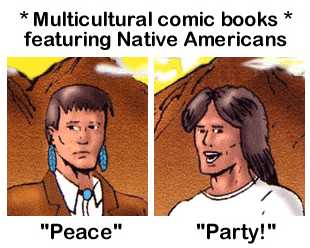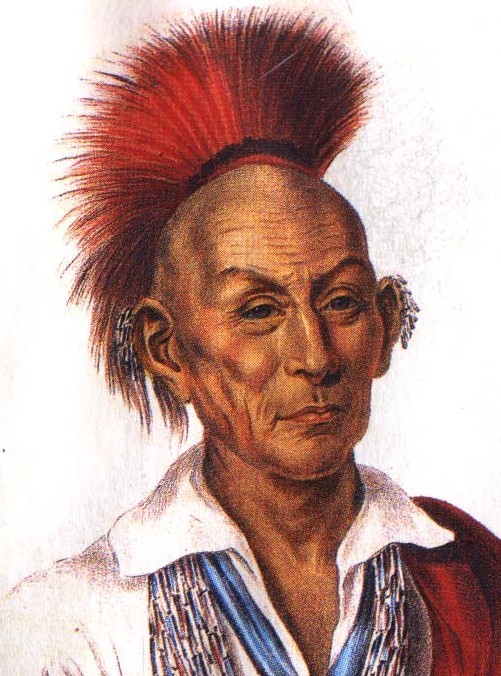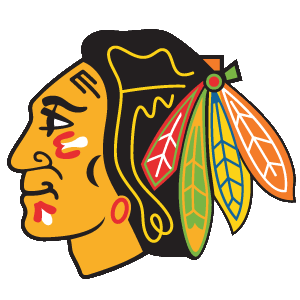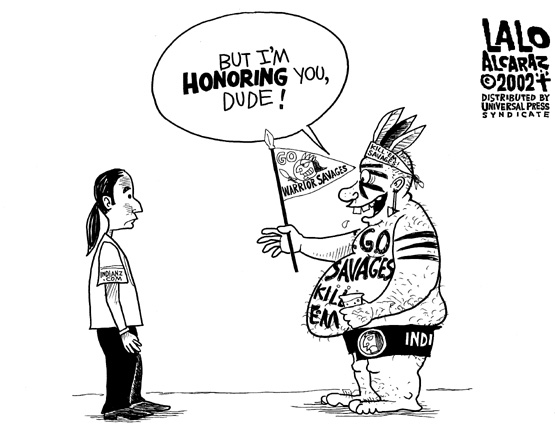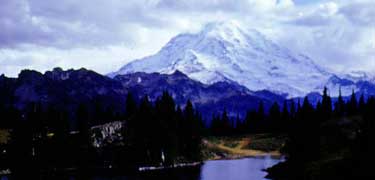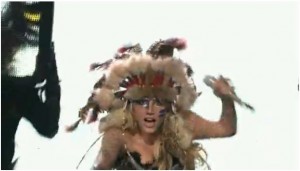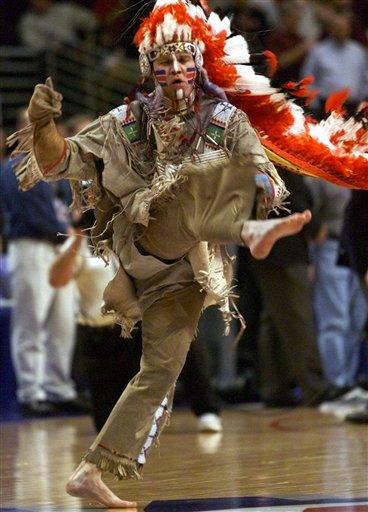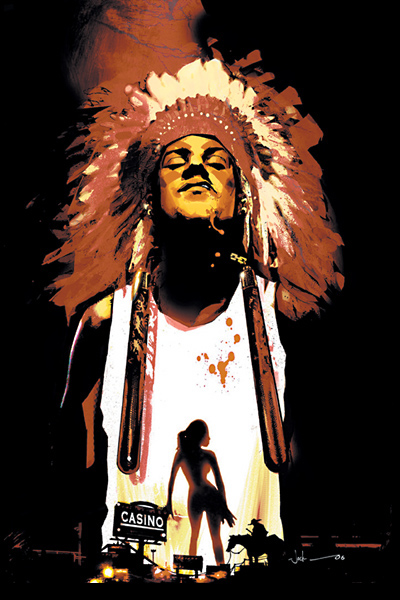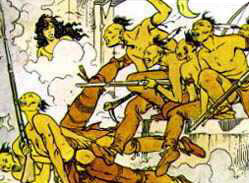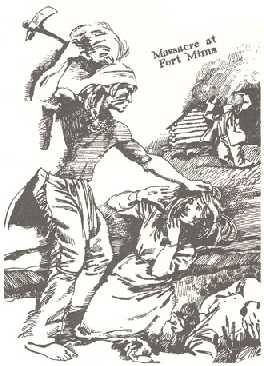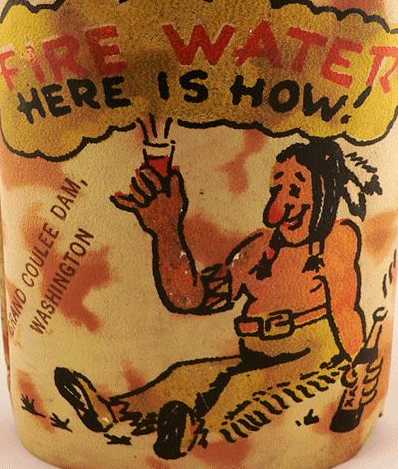We get e-mail:
Mr. Schmidt,
My name is Erik Peterson and I am a Master's student of English at the University of Nebraska at Omaha. I am doing a research project on comic books and graphic novels written and drawn by, and featuring, Native Americans. If you have time available to answer a few questions about your work with "Peace Party," your contribution would be greatly appreciated. As you know, there are very few comic books or graphic novels that appropriately feature Native Americans and Native American issues and "Peace Party" will be a focal point of the project.I agreed to help, so here are the results:
The Q&A interviewMr. Schmidt,
First, I would like to thank you very much for your time. Your contribution to this project is greatly appreciated by myself and will hopefully become a part of a larger movement to bring graphic novels and comics written by, and featuring, Native Americans into the scope of serious scholarly consideration.
To begin, I would like to ask what inspired and led up to the creation of “Peace Party?” What brought your attention to the need for accurate Native American representation in the comic book industry?I've written about the
origin of PEACE PARTY before. Basically, I was always interested in ancient civilizations, including the
Aztecs and Maya. I was also an avid comic-book reader. In my teen and college years, I designed a bunch of superhero costumes, including two that looked vaguely Native.
A decade-plus later, I decided to try writing my own comic book. I thought of doing something about the Greek gods, but someone said that was old hat. I remembered reading about the Hopi ("people of peace") and realized we had our own "foreign" culture in our midst. I thought about those two costume designs and decided they'd make good Native superheroes. Writing about them would give me a chance to critique mainstream America, its
cowboy-style heroes, and its
self-oriented values.
Do you foresee “Peace Party” breaking into a larger, mass-market?I hope it will, but I can't predict that. I'm a self-publisher who has no name-recognition factor in the comics industry. I've learned a lot of
marketing tricks since I published the first two issues, but I'll need them to break through the clutter. With thousands of comics are published every month, it's almost impossible to get the public's attention as an unknown.
Nevertheless, I continue to believe there's a market for intelligent, socially-conscious comic books. The key will be reaching beyond the standard comics markets to people interested in this type of material. With a lot of work and some luck, I think it's doable.
Research and websiteWhat sort of preliminary research was conducted about the Native American tribes that are included as well as the history of the setting itself? Did you find any difficulties when approaching tribal groups in terms of the information they were openly willing to provide? I ask because I have read about and heard about instances where Native American groups are reluctant to open up to outsiders from who are attempting to research issues surrounding indigenous communities.For starters, I did years of research before I began working on the comics. As an outsider who had no special knowledge of Indians at that point, I felt it was essential to gain as much knowledge as possible. So I went to the library and read every issue of the Indian Country Today and Navajo Times newspapers. I subscribed to the Hopi Tutuveni newspaper to get the local outlook. I read novels and reference books and watched movies and documentaries. I visited the reservations in the Southwest, including the exact locations where my first story would take place.
I gingerly approached some Indians--individuals more than groups--about doing a Native-themed comic. Some doubted that a non-Indian like me could do it without stereotyping and offending their people. Others saw the need for good comics and were cautiously encouraging. A few agreed to join my
Board of Advisors, which was a big confidence boost.
Your Web site BlueCornComics.com provides a lot of information beyond the scope of “Peace Party.” Did one come before the other, or inspire the other?In the 1990s I was learning the power of the Internet along with everyone else. I naturally decided to create a site for my comic book.
Initially I planned to save the e-mails I wrote about PEACE PARTY and post them as content. But I kept finding connections between what I was doing and broader political, social, and cultural issues. For instance, we denigrated and
stereotyped Indians for 500 years and we're doing the same with blacks,
gays,
immigrants,
Muslims, and so forth. Our violent approach to solving the "Indian problem" is the way we approach all our problems--our "wars" on poverty, drugs, terrorism, and so forth.
I kept writing about these things, debating with people online, and I posted the material to share my thoughts. So my site kept growing with sections on PEACE PARTY, comic books, Native stereotypes, other Native subjects, stereotyping in general, multiculturalism, culture wars,
violence, and war and
terrorism. I've continued this approach with my
Newspaper Rock blog,
Facebook pages, and
Twitter.
Writing about IndiansHave you received any negative reactions of “Peace Party”--from Native Americans, tribal institutions, or anyone for that matter? Have there been any negative reaction to your not being Native while still writing the subject?Alas, I don't think many people have
read PEACE PARTY, so I haven't gotten many negative reactions. A couple of
reviewers criticized me for being "politically correct," ignoring the fact that Indians were
savages who killed each, and things like that. I don't know if any
paying readers reacted negatively.
I've gotten more negative comments from my website and blog. Occasionally people will say things like, "Who are you to write about Indians? You have no idea what's it's like to be one, no right to your opinion. You don't even care about Indians, you're just trying to sell your comic book." Etc.
Ironically, people occasionally mistake me for an Indian and say things like, "Why do you hate whites/Christians/Americans? Your people lost, get over it. Quit complaining and find something productive to do." Etc.
I've been working in the Native media the last 10 years as well as building my website and blog. So now a lot of people know me and where I'm coming from. I'd say the vast majority of Indians appreciate and support my work. They understand the difference between a genuine friend and a phony who's in it for himself.
In the lifetime of “Peace Party,” have you come across many other authors and artists who are working to bring up similar cultural and historical issues?Well, I was inspired by a lot of great comics. Classics such as GREEN LANTERN/GREEN ARROW, WATCHMEN, DARK KNIGHT RETURNS, and UNCANNY X-MEN. Personal favorites such as SQUADRON SUPREME, D.P. 7, CONCRETE, and EL DIABLO. But those were before the "lifetime" of PEACE PARTY.
People are still doing socially-conscious comics--for instance, Johnson and Pleece's INCOGNEGRO. But I don't see many of them, and the ones I see often aren't as good. These days the Big Two companies (Marvel and DC) aren't doing a lot of interesting things. And it's hard to keep up in general since comics are getting prohibitively expensive.
Of course, Native people are writing and drawing comics also (see below). These people tend to address the cultural and historical issues they were born with. But they reserve the right to tell mindless stories about vigilantes, vampires, and zombies too. <g>
The future of the fieldHave you met many Native American authors or artists in the graphic novel and comic book industry? Do you find a larger, multicultural field of professional authors and artists contributing to this field nevertheless?I've met a few of them in person--people such as the
Healthy Aboriginal Network folks,
Chad Solomon, and
Arigon Starr. And I've "talked" with more online--people such as Jon Proudstar, Robby McMurtry, and Gene Gonzales. I try to keep up with everything they're doing, because it usually has an edge of authenticity.
Because of the demographics, there'll always be more non-Natives doing Native-themed comics. Some will be entertaining and enlightening, while others will be stupid and stereotypical. So you get everything from
SKINWALKERS,
RED PROPHET, and
SCALPED to
COWBOYS & ALIENS,
RIPCLAW, and
THE FOURTH HORSEMAN.
Your Web site has been an exceptional source for information regarding Native Americans featured in comic books and graphic novels, as well as authoring them. From your well-versed perspective, how do you see the future of Native American comic books playing out? I have come across many great examples of Native American comic books, but do you see them making headway in a mass-market environment which still relies on fictionalized, clichéd image of Native Americans?Our society is growing more multicultural, and that bodes well for Native-themed comics in the long run. With the success of
Avatar and the
Twilight books and movies, we're getting closer to recognizing the viability of Native works. A couple of hit movies, TV shows, or comic books featuring Indians may be enough to break the market open.
Until that happens, Native creators will have the same trouble I'm having in drawing attention to our comics. Therefore, we have to work smarter and use the opportunities available to us. Market our comics through blogs and social media. Put them online, on e-book readers and cellphones, etc. Get grants and
partner with tribes to tell their stories in graphic form. Convince the wealthier tribes to
sponsor more arts and entertainment products, including comic books.
Despite the obstacles, the
future is bright. Blockbuster movies are making comics more socially acceptable. Technology is making them easier to create and publish. And the "browning" of America is making people more receptive to the idea of Native heroes. Things can't get much worse than the stereotypical claptrap we've seen in the past, so they have to get better.
For more of my deathless words, see
My Racebending Interviews and
Sheyahshe and Schmidt on the Radio. For more on the subject in general, see
The Best Indian Comics.
